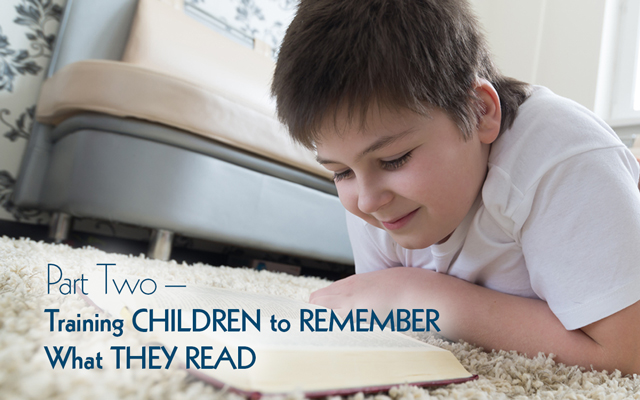Training Children to Remember What They Read – Part Two


In our previous post, we evaluated our reading worldview and the foundation for trading-in our default forgetfulness for strong reading habits. For illustration, I will use Daniel DeFoe’s classic, The Swiss Family Robinson, for practical tips on training children to remember what they read.
Draw Pictures
Research has suggested the memory retains images better than words, especially when that image is created in relation to oral concepts we just learned. Free your little artists into creativity while you read to them or pause at the end of each chapter for a group discussion of what picture would best communicate the story highlights to one who has never read about the Robinson family’s plight. If you can have a real person in mind as you retell the story in image-form (say, the children’s friends or grandparents), bonus points because now you are utilizing the super-memory building power of teaching. Whatever you do, create a picture that expresses the essence of the story. Older readers can vary this method by making notes at the end of each chapter, one-page-per-a-chapter summaries being the recommended method for memory retention.
Build on Previous Knowledge
While reading about the Robinson’s testing the safety of the island food on their chickens and monkey, did any other accounts of people in similar circumstances come to mind? What about their tree house? Have you ever built a tree house? This is known as connecting the dots for your brain, essentially hanging the new knowledge on the appropriate hooks you already have in that cerebrum of yours.
Make it Personal
This is how actors learn their lines by heart and why years later we still remember emotional epochs of our lives vividly. The more emotion you can evoke, the better memory retention. This doesn’t mean becoming overly dramatic. Remember how in the last habit we were connecting dots with knowledge we already have? Do it again, only at an emotional level instead of an intellectual one.
Become a Re-reader
All my life, I’ve known my best enjoyment came from the second reading, rather than the first. And in truth, isn’t this how most of life is? How many people do we know well after one meeting, or how well can you return every item in your neighbor’s house to its proper place after one show? Obviously, if a particular book wasn’t that helpful to us, there is no point in subjecting ourselves to its pages again, but if the information was valuable, deepen your relationship with that knowledge with a second reading.
Will our brains ever be capable of storing the vast library of books most of us will read in a lifetime? Likely not. But as home educators trading our disposable view of reading for intentional, purposeful learning and training our children in constructive reading habits will help burst that 10 percent and make their opportunities for knowledge more productive.
Kenzi Knapp is a follower of Christ, homeschool graduate and student of history. A fourth generation Missourian she enjoys writing about daily life enrolled in Gods great course of faith and His story throughout the ages at her blog, Honey Rock Hills.










































